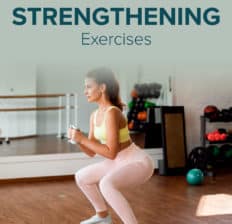This Dr. Axe content is medically reviewed or fact checked to ensure factually accurate information.
With strict editorial sourcing guidelines, we only link to academic research institutions, reputable media sites and, when research is available, medically peer-reviewed studies. Note that the numbers in parentheses (1, 2, etc.) are clickable links to these studies.
The information in our articles is NOT intended to replace a one-on-one relationship with a qualified health care professional and is not intended as medical advice.
This article is based on scientific evidence, written by experts and fact checked by our trained editorial staff. Note that the numbers in parentheses (1, 2, etc.) are clickable links to medically peer-reviewed studies.
Our team includes licensed nutritionists and dietitians, certified health education specialists, as well as certified strength and conditioning specialists, personal trainers and corrective exercise specialists. Our team aims to be not only thorough with its research, but also objective and unbiased.
The information in our articles is NOT intended to replace a one-on-one relationship with a qualified health care professional and is not intended as medical advice.
The Best Knee Strengthening Exercises to Relieve Pain
November 30, 2023
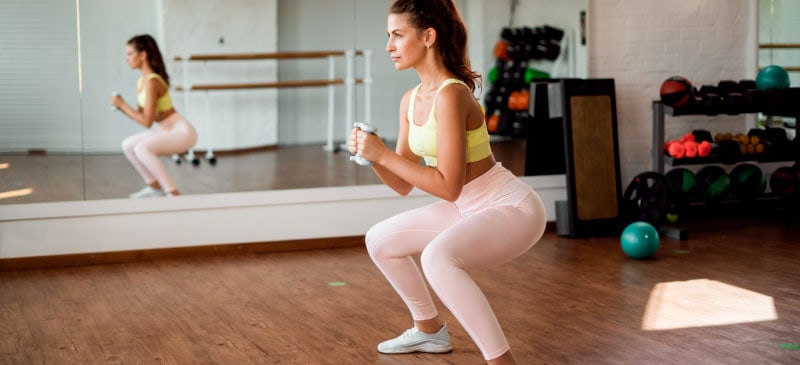
Knee pain is a common ailment among all ages, which is why knee strengthening exercises are important if you want to keep your knees in top shape.
Pain in the knees can strike young women, as early as teenagers or before, and derail a promising (or at least fun!) athletic career. It can result from chronic exercise, and it’s an especially common running injury.
Knee problems can also be anatomical or hereditary, and knee pain can gradually become an issue as one ages.
While it can affect people of all ages, knee pain is more commonly seen with more mature adults due to various forms of arthritis, greatly affecting quality of life. The most common form of arthritis that seems to result in knee pain is called osteoarthritis (OA), which is a musculoskeletal condition.
Knee pain also affects athletes more frequently due to the numerous strains they put on their bodies day to day. There are common ailments, such as iliotibial band syndrome, tendonitis and runner’s knee, that are frequently heard of, but there are way more issues that can surround this complex joint.
Let’s dig in to find out why knee pain is so common and, even better, find out what knee strengthening exercises you can do to reverse that pain.
Reasons for Knee Pain
There are many common reasons for knee pain, and a 2015 study published in the journal Best Practice & Research Clinical Rheumatology indicates that most are work-related or from past injuries. The study states that symptomatic knee osteoarthritis can be viewed as the end result of a molecular cascade that takes place after certain triggers occur and ultimately results in irreversible damage to the articular cartilage.
The study suggests that while there are multiple causes of knee OA, two have attracted particular attention over recent years: occupation-related knee OA and OA subsequent to a previous knee injury.
Studies also report that knee OA is likely to become the eighth most common cause of disability in men and the fourth most common cause of disability in women, according to the World Health Organization report on global burden of disease. Three major physical impairments — knee pain, stiffness and decreased quadriceps strength — are highly associated with knee OA and are believed to contribute to physical disability and progression of the disease.
In general, knee pain is typically caused by two things: arthritis or a sports- or work-related injury.
1. Arthritis
There are several issues and forms of arthritis that affect the knees, including:
- osteoarthritis
- rheumatoid arthritis
- gout
- reactive arthritis
- lyme disease
- lupus
- ankylosing spondylitis
- psoriatic arthritis
- infectious arthritis
2. Injury
Some of the more common knee injuries are:
- meniscal injuries
- anterior cruciate ligament and posterior cruciate ligament injuries
- tendonitis
- bursitis
- loose bodies
- Osgood-Schlatter disease
- dislocated kneecap
- iliotibial band syndrome
- plica syndrome
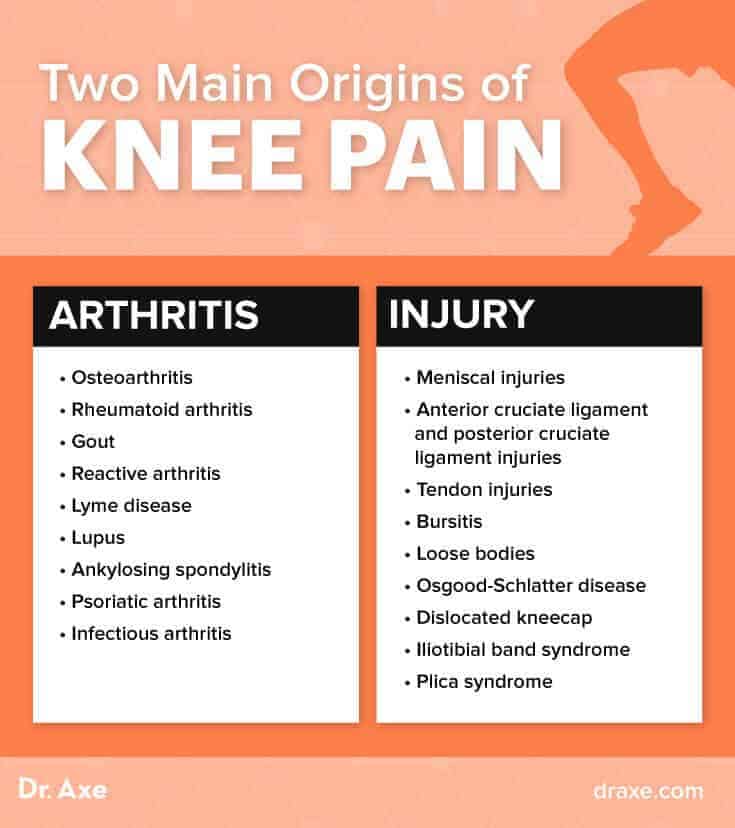
Knee Strengthening Exercises
I suggest performing these knee strengthening exercises on both legs, even though you may only have knee pain on one leg. This will allow for equal strengthening and could actually help support the knee even better.
Also, if you experience any pain, please stop performing the knee strengthening exercises, and consult your doctor, physical therapist or trainer to make sure you are performing these leg exercises correctly.
Take it slow. Over time, you will get stronger!
Beginning Workout
Quadriceps Strengthener
Lay on your back. Place a rolled-up towel or a small foam roller beneath the knee.
Activate the thigh muscles in order to straighten the knee, and hold the contraction for five seconds. Release.
Repeat 10 times on each side. This will strengthen the quadriceps, which in turn will strengthen the knee.
Straight Leg Raise
Lay on your back. Stretch both legs out on the floor.
Lift the right leg up to about six inches off the floor, and hold the contraction for 10 seconds. Make sure to keep abs tight.
It may help to place hands underneath you at the lower area of the back for support as you want to avoid arching. Make sure to engage those quadriceps!
This will strengthen the quadriceps and your core, along with the knees. Repeat five times on each side.
Hip Adduction
Lay on your back on the floor. Bend knees, keeping feet on the floor.
Place a small pillow, lightweight ball or foam roller between the knees. Squeeze the legs toward the object you are holding, and hold for five to 10 seconds.
Release, and repeat 10–20 times. This will strengthen the inner thigh muscles that lead to your knees.
Hip Raise
This movement is also a great glute exercise. Lay on your back on the floor. Bend knees, keeping feet on the floor.
Heels should be close to the butt. Pushing off with the heels, lift the hips toward the ceiling, and hold for five to 10 seconds.
Release, and repeat 10–20 times. This will strengthen the hamstring muscles, which support your knees.
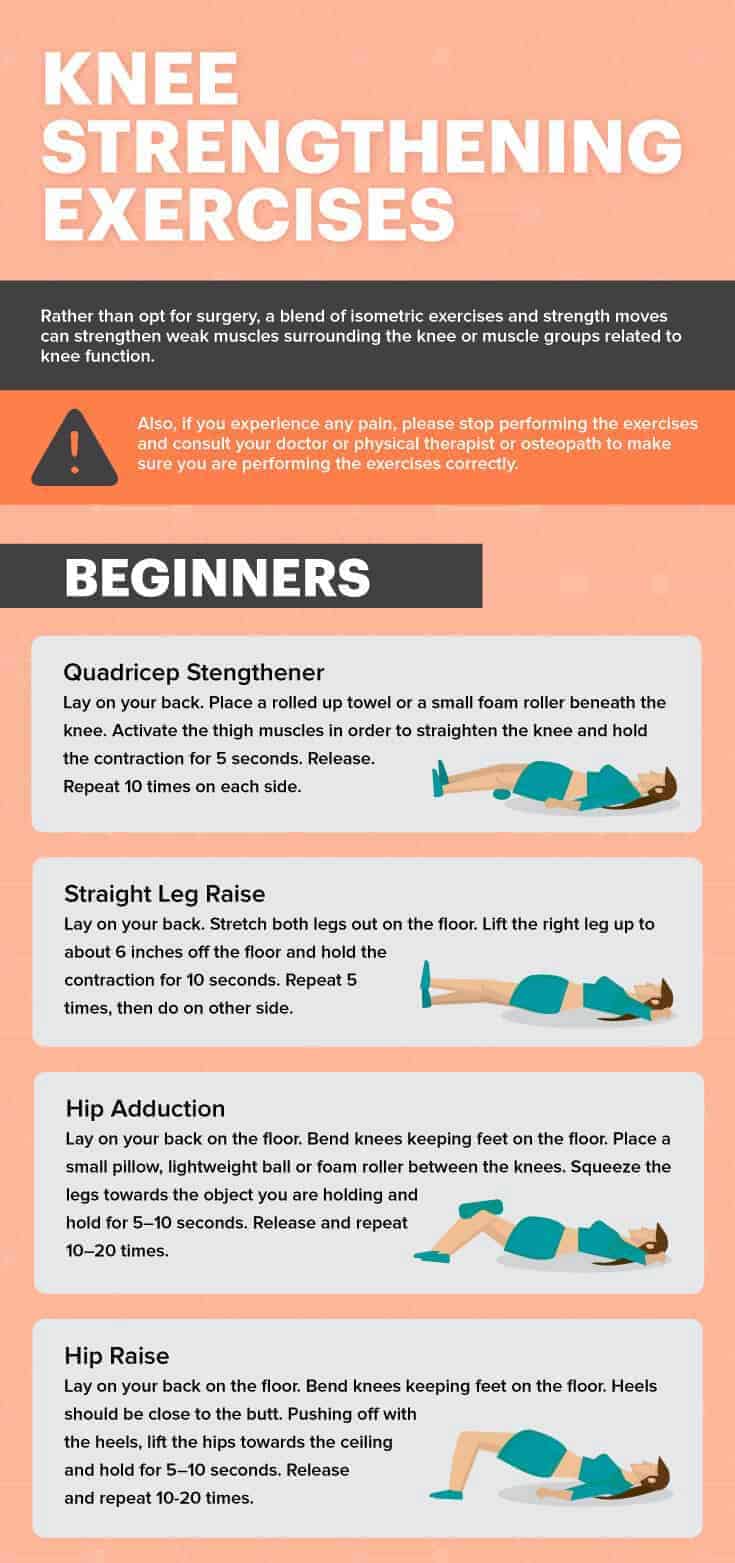
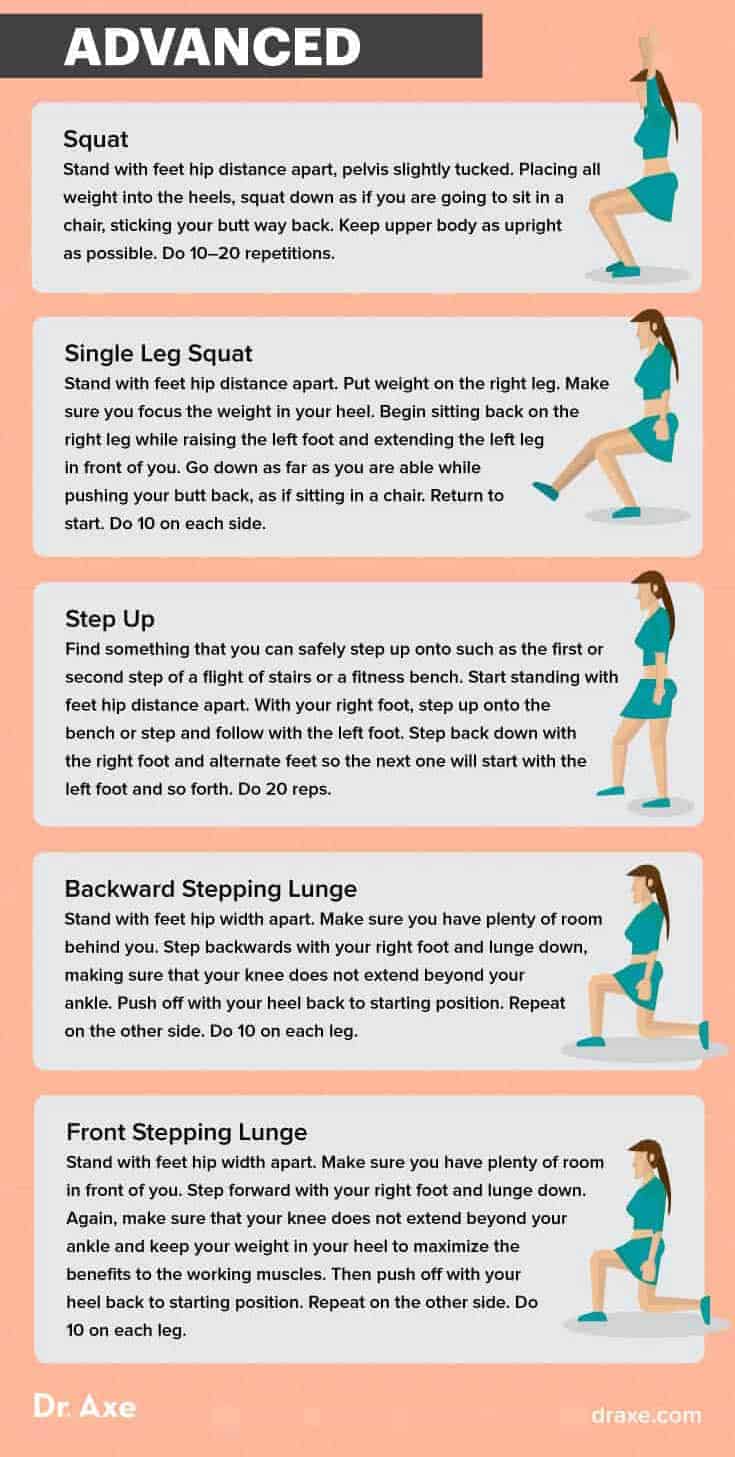
Advanced Workout
Squats
Stand with feet hip-distance apart, pelvis slightly tucked. Placing all weight into the heels, squat down as if you are going to sit in a chair, sticking your butt way back. Keep upper body as upright as possible.
Do 10–20 repetitions. If you want a more advanced version, go deeper, but not below the thighs being parallel with the ground.
Single Leg Squat
This one is tough, but over time, you can accomplish it! Stand with feet hip-distance apart. We will start with putting weight on the right leg.
Make sure you focus the weight in your heel. To keep your balance, start with your left toe touching the ground, and focus on something in front of you that is not moving.
When you are ready, begin sitting back on the right leg while raising the left foot and extending the left leg in front of you. Go down as far as you are able while pushing your butt back, as if sitting in a chair.
Return to start. Do 10 on each side.
Step-Ups
Find something that you can safely step up onto, such as the first or second step of a flight of stairs or a fitness bench. Make sure that whatever you step on, it is sturdy.
Start standing with feet hip-distance apart. With your right foot, step up onto the bench or step, and follow with the left foot.
Step back down with the right foot, and alternate feet so the next one will start with the left foot and so forth. Do 20 reps.
Backward Stepping Lunges
Stand with feet hip-width apart. Make sure you have plenty of room behind you.
Step backward with your right foot, and lunge down, making sure that your knee does not extend beyond your ankle. Push off with your heel back to starting position. Repeat on the other side.
Make sure to keep your upper body erect by maintaining good posture. Do 10 on each leg.
Front Stepping Lunges
Stand with feet hip-width apart. Make sure you have plenty of room in front of you.
Step forward with your right foot, and lunge down. Again, make sure that your knee does not extend beyond your ankle, and keep your weight in your heel to maximize the benefits to the working muscles. Then push off with your heel back to starting position.
Repeat on the other side. Make sure to keep your upper body erect and maintain good posture!
Do 10 on each leg.
Knee Anatomy 101
Let’s dig in to a little knowledge about the knee joint area.
The knee is the joint where the bones of the lower and upper legs meet and thus a very significant part of the body. The knee has a pretty big job because it is what allows us to sit, squat, walk and jump because of its hinge-like feature.
While it’s obviously key to sports success, it’s just as key in our daily functions — so it’s no surprise that when the knees hurt, it can affect our daily living.
The knee consists of three bones: the femur, which is the upper leg bone, or thigh bone; the tibia, which is the bone at the front of the lower leg, or shin bone; and the patella, which is the thick, triangular bone that sits over the other bones at the front of the knee, also known as the kneecap.
Cartilage covers the ends of the bones so they can move easily against one another as they are being used in addition to aiding in the ability to absorb shock.
Two groups of muscles support the knees. One is the hamstring, which is the muscle on the back of the thigh. The hamstrings run from the hip to just below the knee and work to bend the knee.
The other is the quadricep, which is the muscle on front of the thigh that runs from the hip to the knee and straightens the knee from a bent position.
Now that you have a bigger picture of how it all works together, it should make sense that having strong muscles and bones to support the knees can help and may completely eliminate pain. That’s where the knee strengthening exercises above come into play.
How to Treat Knee Pain
The American Academy of Orthopaedic Surgeons suggests exercise-based therapy and knee strengthening exercises as the foundation for treating knee osteoarthritis and knee pain-related issues, and if necessary, weight loss should be encouraged for all patients with any sort of knee pain.
It is common for patients to work with a physical therapist who can help determine knee strengthening exercises that are most appropriate for them at certain stages of pain and limited mobility. The Osteoarthritis Research Society International recommends non-pharmacological methods, including patient education programs, weight reduction, coping strategies and exercise programs for treatment, including alternative therapy programs like rolfing.
What specific knee strengthening exercises can be done? First, the reason exercise is so great is because it is important to maintain a range of motion, and to do that, you need the muscles that support the knees to be strong and healthy!
Research shows minor increases in the strength of the quadriceps (by routinely doing quad exercises) can help reduce the risk of knee osteoarthritis and its progression as well as reducing the pain. Exercise can be effective for those suffering from arthritis as well due to the support it provides to the joint area. It is important to choose the right knee strengthening exercises and do them properly.
There are three types of basic therapeutic exercise that may help strengthen the knee area: isotonic, isokinetic and isometric exercise. Of these three, isometric exercise might be the most appropriate and easy to understand for patients and can be easily and safely performed at home or when traveling because it requires no or minimal equipment.
Further, isometric exercise causes the least inflammation and pressure. Isometric exercises are simple to perform and rapidly improve strength.
There are other more advanced, dynamic exercises for knee pain, such as shallow to deep squats, step-ups, weightlifting and leg lifts. You can start off with easier versions of each of these, working your way up to more advanced options as you gain more strength and as a result feel less pain.




